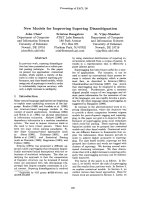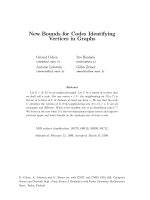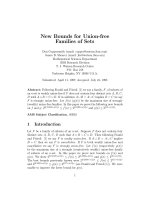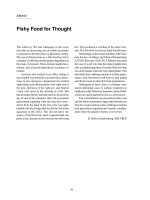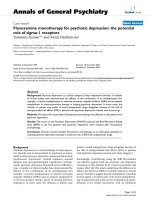Báo cáo y học: "New hope for haplotype mapping" pptx
Bạn đang xem bản rút gọn của tài liệu. Xem và tải ngay bản đầy đủ của tài liệu tại đây (35.26 KB, 3 trang )
51
HLA = human leukocyte antigen; LD = linkage disequilibrium.
Available online />Introduction
Individual risk of developing most major diseases can be
largely attributed to the extensive single nucleotide varia-
tion that occurs throughout the human genome. The iden-
tification of the functional variants that contribute to
disease risk and progression, however, has been difficult,
particularly for complex diseases where the interplay of
genes and environment is most evident.
Relatively minor degrees of genetic variation can lead to
substantial structural and functional changes — as evi-
denced by the modest changes that distinguish primate
species or that can produce profound disease phenotypes
in Mendelian-related traits. Attempts to identify DNA vari-
ants that contribute to complex disease through linkage
analysis with genome wide markers in families have pro-
vided localisation of large genetic effects, but few actual
disease-mediating polymorphisms. Association strategies,
including genome wide association, provide a theoretically
more powerful methodology for identifying disease poly-
morphisms, but also present new methodological and sta-
tistical challenges. These have, however, provided hope
that such variants can now be identified.
One challenge in applying association methodology is to
identify functional variants without analysing every poly-
morphism in a genomic region, which may be as frequent
as 1/1000 base pairs in regions of the genome. If all the
polymorphisms had achieved equilibrium through recombi-
nation with each other, so that adjacent polymorphisms
occur together at a frequency determined only by their
allele frequency, this task would be enormous. Fortunately,
for much of the genome the distribution of alleles is not in
equilibrium, reducing the scale of the challenge of extract-
ing all the necessary genetic information from some
genomic regions.
The occurrence of a set of polymorphisms along a single
chromosome is referred to as a haplotype. The frequency
with which polymorphisms reside together on a haplotype
is dependent on a number of factors: the evolutionary
history of the population studied, the recombination fre-
quency and recombination hot-spots sites along the chro-
mosome, and the evolutionary selection of advantageous
or disadvantageous functional variants. When alleles at
adjacent sites are found together more often than would
be expected if the region were in equilibrium, they are said
to be in linkage disequilibrium (LD). The result of LD is that
particular combinations of alleles are conserved across
haplotypes, and typing any one of these will provide infor-
mation across the whole haplotype. The obvious benefit is
that information about association can be attained across
large genomic regions by typing only very small numbers
of single nucleotide polymorphisms.
The importance of LD for those interested in finding
disease genes in the genome is well illustrated by the
human leukocyte antigen (HLA) region. Genetic typing
Commentary
New hope for haplotype mapping
John I Bell
John Radcliffe Hospital, Oxford, UK
Corresponding author: John Bell (e-mail: )
Received: 1 November 2002 Accepted: 20 November 2002 Published: 13 January 2003
Arthritis Res Ther 2003, 5:51-53 (DOI 10.1186/ar621)
© 2003 BioMed Central Ltd (Print ISSN 1478-6354; Online ISSN 1478-6362)
Abstract
The systematic analysis of polymorphisms across large parts of the human genome has begun to
provide the first information on haplotypes and the problem of linkage disequilibrium across large
genomic regions. These data suggest that significant regions of the gnome show highly conserved
haplotypes, potentially enhancing the ability to detect disease associations.
Keywords: evolution, genetics, haplotypes, human leukocyte antigen
52
Arthritis Research & Therapy Vol 5 No 2 Bell
was available here long before molecular genetic tech-
nologies arrived because the polymorphism on these
genes was recognisable through the use of serological
reagents. Early studies revealed the association between
individual alleles and human disease. For example, the ear-
liest associations between HLA and type I diabetes
revealed that HLA B8 was associated with the disease. As
typing became widespread, it became clear that the HLA
region on chromosome 6 was a genomic region that con-
tained strong LD. This meant that certain alleles could
define ancestral haplotypes with LD extending over very
large distances (up to 3 cM) and that the association of
any one of many alleles could implicate a haplotype asso-
ciated with disease. This led to the rapid association of
the A1 B8 DR3 haplotype with a range of autoimmune dis-
orders, including diabetes in Caucasian populations.
Eventually, the true functional variants that confer suscep-
tibility to type I diabetes were shown to arise from the HLA
class II region, a megabase away from the those variants
originally shown to associate with disease. Most other
HLA disease associations relied upon LD initially to be
identified. Thirty years later, these associations remain the
best examples of complex trait genetic associations to be
documented, despite years of molecular genetic mapping.
It has been assumed by many that the extent of LD sur-
rounding the HLA was special and that the lessons
learned from exploring the disease gene in this region of
high allelic association would not be applicable to the rest
of the genome. As attention in disease gene hunting
moved from genome wide linkage studies to the explo-
ration of linked regions, and as the idea of whole genome
association as a plausible method for identifying disease
polymorphisms arose, there has been renewed interest in
establishing how much LD exists elsewhere in the
genome. If there were extensive regions outside the HLA
that could be defined by a relatively small number of
markers, the job of identifying regions containing disease
genes would be made much easier. Large regions of the
genome could then be scanned with existing technology,
without it being necessary to type every DNA variant indi-
vidually in an attempt to identify the functional polymor-
phism responsible for a disease.
Until recently, only a few studies provided limited informa-
tion about the extent of LD around the genome. Two publi-
cations have appeared that provide an indication of LD; one
having typed DNA variants in 51 autosomal regions of the
genome [1], and the other having intensively typed polymor-
phisms across the whole of the long arm of chromosome 22
[2]. These two publications provide our first glimpses into
the haplotypes that might exist within the genome and have
important implications for our ability to map disease genes
in the near future. Interestingly, these publications have
taken rather different approaches to their studies and have
generated somewhat different conclusions.
Gabriel et al. [1] analysed 3738 polymorphisms in a range
of ethnic groups across 51 autosomal regions averaging
250,000 base pairs in length. Their paper identified many
haplotype blocks, defined as a region over which a very
small proportion (< 5%) of comparisons among informa-
tive single nucleotide polymorphisms show strong evi-
dence of historical recombination. This is an extremely
rigorous test of LD, requiring almost complete allelic asso-
ciation across the haplotypes. Gabriel et al. used markers
at close intervals (on average every 7.8 kb) and, as a
result, generated data on a large amount of LD that is
known to occur at short intervals. The vast majority of the
haplotype blocks defined in this study were in regions
< 5 kb, a distance well recognised to be associated with
strong LD in Caucasian populations. The extreme criteria
for defining haplotypes contributed to Gabriel et al.’s
observation that LD does appear to decline with the dis-
tance between markers within a haplotype block. This
study is largely measuring almost pure, conserved haplo-
types that, on average, are 11 kb in length in Nigerian and
Afro-American samples, and are 22 kb in length in Euro-
pean and Asian samples. These haplotypes could be iden-
tified by as few as six to eight markers. Based on these
data, the authors estimate that 300,000–1,000,000 single
nucleotide polymorphisms would be necessary to have a
fully powered genome wide association strategy using this
sort of haplotypic information.
Dawson et al. [2] took a different approach that results in
significantly different conclusions. They used markers that,
on average, are 15 kb apart across the whole of the long
arm of chromosome 22. This study was able to look at
much larger regions of LD, using 1504 markers across the
chromosome and using conventional measures of LD (D′
and r
2
) rather than the more stringent criteria used by
Gabriel et al. [1]. This provides evidence for haplotype
blocks that are less pure, but extend over much longer
regions. As one would expect, LD decays over increasing
distance in these haplotypes. The regions of extensive LD
correlate with regions of the chromosome known to have
low recombination rates. The longest haplotype network
seen by this group was 804 kb in length containing
16 markers, while 25 markers make up a haplotype
network of 758 kb elsewhere on the chromosome. These
are not completely pure haplotypes, but represent regions
where low rates of recombination have, in European popu-
lations, long conserved haplotype networks that can be
defined by a relatively small number of markers.
What then should the gene mappers conclude from these
apparently disparate results? By defining haplotypes very
rigorously, one will find many short stretches of virtually
complete LD in the genome. A less stringent approach
can establish the presence of longer ancestral haplotypes
across which the levels of LD vary, but which reduce the
complexity of genotyping necessary to describe the
53
region. The best way to evaluate what might be valuable is
to again review what has already proved useful in the HLA.
Although it has not been demonstrated that the LD across
the HLA is broken up by punctate regions of recombina-
tion, the haplotypes and LD patterns that have helped
define disease associations often operate across these
sites. Long-range LD has proved powerful as many class II
associations originated with class I associations. None of
these HLA haplotypes are complete or pure; most repre-
sent ancestral haplotypes on which new variants have
arisen. In some cases, they extend from well beyond the
HLA-A locus at one end to the HLA-DP at the other.
Despite their size, they have proved immensely valuable in
disease gene mapping. One would argue, therefore, that
the approach used by Dawson et al. [2] may provide
better estimates of what will be useful in real studies of
disease genes.
It is important also to remember that, although LD and
conserved haplotypes may assist in identifying regions
associated with disease, it also makes the final identifica-
tion of disease mutations more difficult. Regions of LD
contain multiple DNA variants, all of which may be
strangely associated with a disease, due to being on the
same conserved haplotype. This can make the precise
identification of the functional variant extremely difficult, as
has been seen within the HLA. Only transracial studies
that break down LD and conserved haplotypes can
resolve these challenging issues.
Conclusion
Identifying disease-related genetic polymorphisms in
common disease has never been easy. Recognising,
however, that patterns of LD that were previously thought
confined to the HLA are in fact much more widespread
should greatly facilitate the introduction of hypothesis-free
association strategies.
Competing interests
None declared.
References
1. Gabriel SB, Schaffner SF, Nguyen H, Moore JM, Roy J, Blumen-
stiel B, Higgins J, DeFelice M, Lochner A, Faggart M, Liu-Cordero
SN, Rotimi C, Adeyomo A, Cooper R, Ward R, Lander ES, Daly
MJ, Altshuler D: The structure of haplotype blocks in the
human genome. Science 2002, 296:2225-2229
2. Dawson E, Abecasis GR, Bumpstead S, Chen Y, Hunt S, Beare
DM, Pabial J, Dibling T, Tinsley E, Kirby S, Carter D, Papaspyri-
donos M, Livingstone S, Ganske R, Lõhmussaar E, Zernant J,
Tõnisson N, Remm M, Mãgl R, Puurand T, Vilo J, Kurg A, Rice K,
Deloukas P, Mott R, Metspalu A, Bentley DR, Cardon LR, Dunham
I: A first-generation linkage disequilibrium map of human
chromosome 22. Nature 2002, 418:544-548.
Correspondence
John I Bell, Regius Professor of Medicine, John Radcliffe Hospital,
Oxford OX3 9DU, UK. Tel: +44 1865 221340; fax: +44 1865
220993; e-mail:
Available online />

